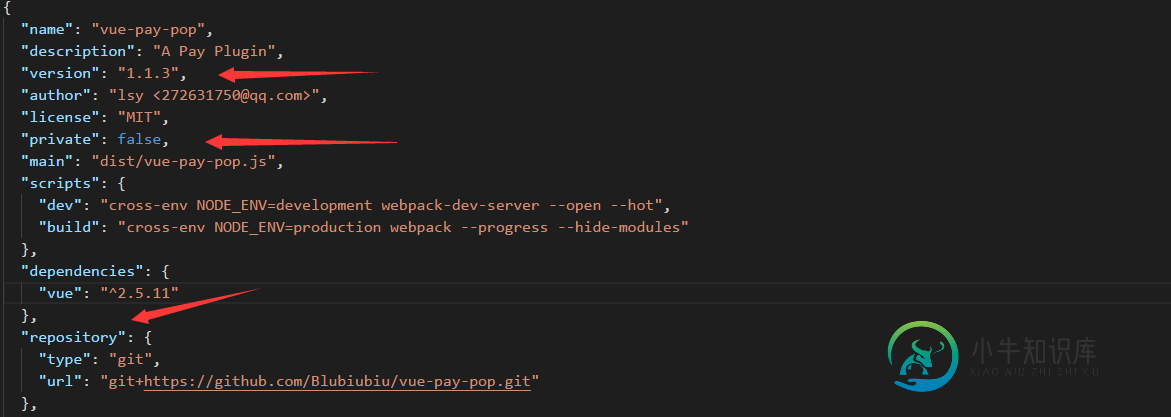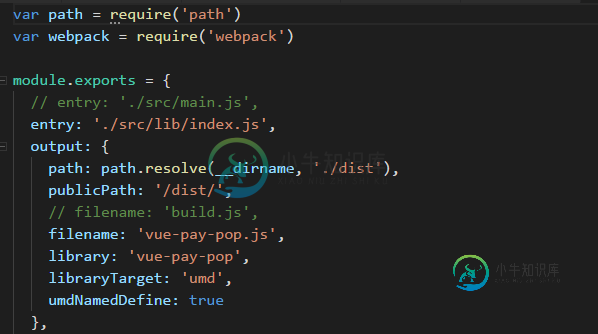vue2.0+ 从插件开发到npm发布的示例代码
vue: V2.5.11
此篇尽量详细,清楚的讲解vue插件的开发到npm的发布,想想将你自己做的东西展示给广大“网民”,心里还是有点小激动的...…^_^
先上一下插件效果图------github传送门

下面我们就来说说详细做法:
1. 初始化项目
vue init webpack-simple vue-pay-keyboard
使用vue创建一个简单的项目,删除src中除了main.js和app.vue外的文件,清空app.vue中无用内容
整理完后项目目录

2.编写插件
vue-pay-pop (源码大家可到github中自行获取)
<template> <div class="pay-box"> <!-- 输入框及键盘 --> <div :class="payPopOptions.isShow? 'pay-wrapper pay-wrapper-active' : 'pay-wrapper'"> <div class="pay-container" v-if="status"> <div class="pay-title"> {{title}} <div class="close-pay" @click="closePay"> <svg t="1501505446265" viewBox="0 0 1024 1024" version="1.1" xmlns="http://www.w3.org/2000/svg" p-id="1904" xmlns:xlink="http://www.w3.org/1999/xlink" width="18" height="18" class="icon"><path data-v-7c990886="" d="M550.659 490.565l324.395-324.386c10.945-10.945 10.945-28.699 0-39.644-10.948-10.95-28.704-10.95-39.648-0.004L511.01 450.916 186.625 126.53c-10.946-10.947-28.703-10.947-39.648 0-10.946 10.95-10.946 28.703 0 39.648l324.385 324.386-324.385 324.401c-10.946 10.944-10.946 28.703 0 39.65 10.945 10.943 28.702 10.943 39.648 0L511.01 530.213l324.396 324.401c10.944 10.944 28.7 10.944 39.648 0 10.945-10.946 10.945-28.705 0-39.649L550.66 490.565z" p-id="1905"></path></svg> </div> </div> <div class="pay-input-wrapper"> <div class="pay-input" v-for="(item, index) in pwdLength" :key="index"> <input type="password" :value="val[index]" disabled> </div> </div> <div class="pay-keyboard-wrapper"> <div class="pay-keyboard"> <div class="pay-key" v-for="item in keyBoards" :key="item" @click="val2input(item)"> {{item}} </div> </div> <div class="pay-keyboard-bottom"> <div class="pay-key-bottom pay-key-blank"></div> <div class="pay-key-bottom pay-key-middle" @click="val2input('0')">0</div> <div class="pay-key-bottom pay-key-del" @click="delVal" v-html="del"></div> </div> </div> </div> <!-- 结果显示 --> <div class="pay-result" v-if="!status"> <div class="loader"></div> <div>{{loadingTxt}}</div> </div> </div> <!-- 遮罩层 --> <div class="gray-wrapper" v-show="payPopOptions.isShow"></div> </div> </template>
export default {
name: 'vue-pay-pop',
props: ['payPopOptions'],
data () {
return {
//可选参数,支持改变
//顶部文字
title: this.payPopOptions.title || '请输入支付密码',
//密码长度
pwdLength: this.payPopOptions.pwdLength || 6,
//底部删除按钮
del: this.payPopOptions.del || '<svg t="1524794920212" class="icon" style="" viewBox="0 0 1024 1024" version="1.1" xmlns="http://www.w3.org/2000/svg" p-id="1048" xmlns:xlink="http://www.w3.org/1999/xlink" width="40" height="30"><defs><style type="text/css"></style></defs><path d="M798.675138 191.774745c44.172035 0 80.109526 35.753295 80.109526 79.69918l0 445.373557c0 43.945885-35.93749 79.69918-80.109526 79.69918L382.443295 796.546661c-25.555026 0-49.780777-12.279674-64.804958-32.845059L154.967444 541.013801c-20.472264-28.025287-20.472264-65.680908 0-93.707219L317.638337 224.617757c15.023158-20.566408 39.249933-32.843012 64.804958-32.843012L798.675138 191.774745M798.675138 177.709401 382.443295 177.709401c-30.16502 0-58.508555 14.365172-76.240405 38.641065L143.531997 439.038268c-24.009833 32.865525-24.009833 77.378321 0 110.245893l162.670893 222.685755c17.732873 24.276916 46.075385 38.641065 76.240405 38.641065l416.231843 0c52.051493 0 94.247524-41.977044 94.247524-93.762477l0-445.373557C892.922662 219.688491 850.726631 177.709401 798.675138 177.709401L798.675138 177.709401zM475.470015 356.690772l218.792075 218.791052c10.984169 10.986215 10.984169 28.795836 0 39.780005-10.986215 10.986215-28.795836 10.986215-39.781028 0L435.69001 396.470777c-10.986215-10.984169-10.986215-28.795836 0-39.780005C446.674179 345.704556 464.485847 345.704556 475.470015 356.690772zM437.268972 578.919109l223.685525-224.042659c11.228739-11.247158 29.438473-11.247158 40.669258 0 11.230786 11.249205 11.230786 29.487591 0 40.73475L477.93823 619.654882c-11.228739 11.249205-29.438473 11.249205-40.669258 0C426.039209 608.404654 426.039209 590.167291 437.268972 578.919109z" p-id="1049" fill="#1296db"></path></svg>',
//默认等候文字
loadingTxt: this.payPopOptions.loadingTxt || '请稍候...',
//默认等候时间
loadingTime: this.payPopOptions.loadingTime || 1000,
//显示结果后,多久重回默认
resultTime: this.payPopOptions.resultTime || 1000,
//成功文字
successTxt: this.payPopOptions.successTxt || '支付成功',
//失败文字
failTxt: this.payPopOptions.failTxt || '支付失败',
//默认参数,无法改变
//键盘数字(1~9)
keyBoards: ['1', '2', '3', '4', '5', '6', '7', '8', '9'],
//键入的值
val: [],
//默认输入框与等待层是否显示
status: true
}
},
methods: {
val2input(item) {
this.val.push(item)
if (this.val.length == this.pwdLength) {
//打开等待层
this.status = false
//输入完毕后将值传递给父组件
this.$emit('inputDown', this.val.join(''))
//清空数据
this.val = []
}
},
delVal () {
if (this.val.length > 0) this.val.pop()
},
closePay () {
this.payPopOptions.isShow = false;
},
$payStatus(flag = false) {
const that = this
//模拟等候feel
setTimeout(() => {
if (flag) {
//成功
this.loadingTxt = this.successTxt
//关闭输入层,重置等待语
setTimeout(function() {
that.payPopOptions.isShow = !flag
that.status = true
that.loadingTxt = that.payPopOptions.loadingTxt || '请稍候...'
}, this.resultTime)
} else {
//失败
this.loadingTxt = this.failTxt
//重新打开输入层,重置等待语
setTimeout(function() {
that.status = true
that.loadingTxt = that.payPopOptions.loadingTxt || '请稍候...'
}, this.resultTime)
}
}, this.loadingTime)
}
}
}
基本源码都在这里了,实现方法比较简单,这里就不多过介绍了...
3.尝试使用
我们先尝试在本地app.vue中使用
<div id="app"> <div @click="showPayPop">点击弹出支付框</div> <vue-pay-pop ref="pay" :payPopOptions="payPopOptions" @inputDown="inputDown"></vue-pay-pop> </div>
import vuePayPop from './lib/vue-pay-pop'
export default {
name: 'app',
data () {
return {
payPopOptions: {
isShow: false
},
}
},
components: {
vuePayPop
},
methods: {
inputDown(val) {
//模拟检查数据
setTimeout(() => {
if (val == '111111') {
this.$refs.pay.$payStatus(true)
} else {
this.$refs.pay.$payStatus(false)
}
}, 1000)
},
showPayPop() {
this.payPopOptions.isShow = true;
}
}
}
其中payPopOptions中isShow是必传项,用来控制弹出框的显隐
其他更多参数为可选参数

4.更改配置文件
ok,现在我们去更改配置文件,为我们的发布做准备
index.js
import vuePayPop from './vue-pay-pop.vue'
const PayPop = {
install(Vue, options) {
Vue.component(vuePayPop.name, vuePayPop)
}
}
if (typeof window !== 'undefined' && window.Vue) {
window.PayPop = PayPop
Vue.use(PayPop)
}
export default PayPop
package.json

修改箭头中所指
1. 你的插件版本号,以后每次上传npm都需要更改
2. 不设为false无法发布
3. 填写你自己的github托管地址(如何将代码上传github就不说了,大家可以参考Git教程---廖雪峰)
webpack.config.js

修改entry和filename
index.html
<div id="app"></div> <script src="/dist/vue-pay-pop.js"></script>
dist文件大家在命令行中输入npm run build就会自定生成
5.发布npm
你需要去npm官网注册一个npm帐号
注册好后

输入你的用户名,密码,邮箱(密码是不显示的)
成功登录后我们在输入

ok,我们就发布成功!
6.引用
在你的项目中 npm install vue-pay-pop --save 下载我们的包
main.js
import vuePayPop from "vue-pay-pop" vue.use(vuePayPop)
这样我们就可以在自己的vue文件中直接引用啦...
ok,那到这里我们的内容就结束了。
另外如果大家觉得有用的话,欢迎github上献上您的star,当然也可以在评论或issues中向我提出您的问题与建议,十分感谢。
以上就是本文的全部内容,希望对大家的学习有所帮助,也希望大家多多支持小牛知识库。
-
本节作者:NERO 我们知道Linux系统有些日志不是以可读文本形式存在文件中,而是以二进制内容存放的。比如utmp等。 Files插件在读取二进制文件和文本文件的区别在于没办法一行行处理内容,内容也不是直观可见的。但是在其他处理逻辑是保持一致的,比如多文件支持、断点续传、内容监控等等,区别在于bytes的截断和bytes的转换。 在Files的基础上,新增了个插件utmp,插件实现了对二进制文件
-
本文向大家介绍vue2.0之多页面的开发的示例,包括了vue2.0之多页面的开发的示例的使用技巧和注意事项,需要的朋友参考一下 我们平常用vue开发的时候总觉得vue好像就是专门为了单页面应用而诞生的,其实不是。因为vue在工程化开发的时候很依赖webpack,而webpack是将所有的资源整合到一块,弄成一个单页面。但是vue不止可以做单页面,它还可以做多页面,如果要做多页面的话需要对他的依赖,
-
CMS发布插件开发 使用“后台»工具&开发»开发»CMS发布插件”可快速生成插件 我们用个示例来演示如何制作插件,首先确定我们的需求:将采集的文章发布到wordpress程序里 输入插件名称:wordpress文章入库,CMS程序选择wordpress,插件功能标识:article(表示文章入库),作者版权填你自己的 然后添加参数,什么是参数呢?参数在界面中是可视化的控件,可绑定或输入数据,方便用
-
上一节介绍了如何给 Kibana 开发浏览器端的可视化插件。新版 Kibana 跟 Kibana3 比,最大的一个变化是有了独立的 node.js 服务器端。那么同样的,也就有了服务器端的 Kibana 插件。最明显的一个场景:我们可以在 node.js 里跑定时器做 Elasticsearch 的告警逻辑了! 本节示例一个最基础的 Kibana 告警插件开发。只演示基础的定时器和 Kibana
-
前面两节,我们分别看过了如何开发可视化部分和服务器端部分。现在,我们把这两头综合起来,做一个可以在 Kibana 菜单栏上切换使用的,完整的 app。就像 Kibana 5 默认分发的 timelion 和 console 那样。 当然我们这里不会真的特意搞一个很复杂的可视化应用。我们只做一个 Elasticsearch 状态展示页面就好了。这个方式正好可以串联从前到后的请求、展示部分。 app
-
上一节,我们看到了一个完整的 Kibana 插件的官方用例。一般来说,我们不太会需要自己从头到尾写一个 angular app 出来。最常见的情况,应该是在 Kibana 功能的基础上做一定的二次开发和扩展。其中,可视化效果应该是重中之重。本节,以一个红绿灯效果,演示如何开发一个 Kibana 可视化插件。 插件目录生成 Kibana 开发组提供了一个简单的工具,辅助我们生成一个 Kibana 插

